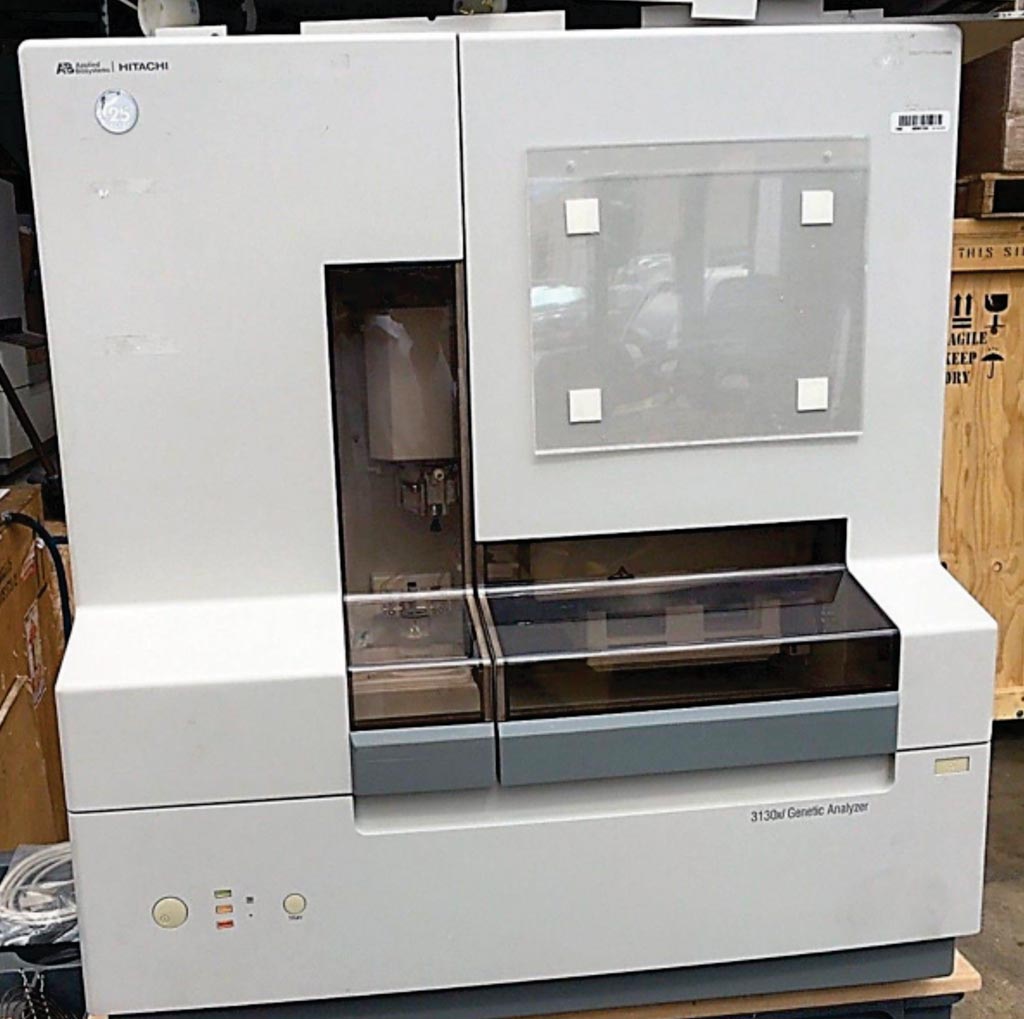Assay May Boost Treatment of Non-Hodgkin Lymphoma
|
By LabMedica International staff writers Posted on 14 Nov 2017 |

Image: The Hitachi ABI 3130XL capillary electrophoresis genetic analyzer system (Photo courtesy of Cal-L enterprises).
Diffuse large B-cell lymphoma (DLBCL) is an aggressive cancer and the most frequently diagnosed non-Hodgkin lymphoma worldwide. Recent advancements indicate that both the prognosis and choice of treatment of DLBCL may depend on identifying its molecular subtype.
DLBCL includes three major subtypes termed germinal center B-cell-like, activated B-cell-like, and primary mediastinal B-cell lymphoma. A reliable, accessible, rapid, and cost-effective new gene expression signature assay has been developed that can enhance lymphoma management by helping to match tumors with the appropriate targeted therapy.
A team of scientists working with those at the Centre Henri Becquerel (Rouen, France) collected a total of 218 biopsy samples, including fresh/frozen biopsies of 150 DLBCL cases had previously been analyzed using U133 + 2 GEP arrays. A total of 38 primary mediastinal B-cell lymphoma (PMBL) cases from another trial and 29 from the Center Henri Becquerel, were also included as well as 30 DLBCL cases from the same institution.
The investigators extracted RNA samples from formalin-fixed paraffin-embedded (FFPE) tissue using Siemens TPS and Versant reagents kit. Immunoperoxidase stains were performed on a Benchmark Ultra automated stainer using Ultraview Universal diaminobenzidine detection kits. A rapid and inexpensive reverse transcriptase multiplex ligation-dependent probe amplification (RT-MLPA) assay was developed that allows for an accurate classification of germinal center B-cell-like (GCB) and activated B-cell-like (ABC) DLBCLs. The resulting MLPA amplicons were analyzed by fragment analysis using an ABI 3130 XL capillary electrophoresis system.
The team tested 150 RNA samples extracted from biopsies and 42% of the samples had the ABC subtype, 37% the GCB subtype, and 10% molecular PMBL, while 11% of samples could not be classified. Overall, the RT-MLPA assay correctly assigned 85.0% of the cases into the expected subtypes compared to 78.8% with immunohistochemistry. The assay was also able to detect the MYD88 L265P mutation, one of the most common genetic abnormalities found in ABC DLBCLs. This information can influence treatment, since the presence of the mutation has been suggested to be predictive of ibrutinib sensitivity.
The authors concluded that RT-MLPA appears as an efficient, rapid, and cost-effective alternative to the current methods used in the clinic to establish the cell of origin classification of DLBCLs. In contrast to other technologic approaches its implementation requires only common laboratory equipment, that is, a thermal cycler and a capillary genetic analyzer, and does not necessitate the acquisition of any specialized platform. By allowing the identification of the three major DLBCL subtypes and a simultaneous evaluation of multiple prognostic and theranostic markers and therapeutic targets, RT-MLPA could contribute to a more efficient management of these aggressive tumors in both clinical trials and daily practice. The study was published in the November 2017 issue of the Journal of Molecular Diagnostics.
Related Links:
Centre Henri Becquerel
DLBCL includes three major subtypes termed germinal center B-cell-like, activated B-cell-like, and primary mediastinal B-cell lymphoma. A reliable, accessible, rapid, and cost-effective new gene expression signature assay has been developed that can enhance lymphoma management by helping to match tumors with the appropriate targeted therapy.
A team of scientists working with those at the Centre Henri Becquerel (Rouen, France) collected a total of 218 biopsy samples, including fresh/frozen biopsies of 150 DLBCL cases had previously been analyzed using U133 + 2 GEP arrays. A total of 38 primary mediastinal B-cell lymphoma (PMBL) cases from another trial and 29 from the Center Henri Becquerel, were also included as well as 30 DLBCL cases from the same institution.
The investigators extracted RNA samples from formalin-fixed paraffin-embedded (FFPE) tissue using Siemens TPS and Versant reagents kit. Immunoperoxidase stains were performed on a Benchmark Ultra automated stainer using Ultraview Universal diaminobenzidine detection kits. A rapid and inexpensive reverse transcriptase multiplex ligation-dependent probe amplification (RT-MLPA) assay was developed that allows for an accurate classification of germinal center B-cell-like (GCB) and activated B-cell-like (ABC) DLBCLs. The resulting MLPA amplicons were analyzed by fragment analysis using an ABI 3130 XL capillary electrophoresis system.
The team tested 150 RNA samples extracted from biopsies and 42% of the samples had the ABC subtype, 37% the GCB subtype, and 10% molecular PMBL, while 11% of samples could not be classified. Overall, the RT-MLPA assay correctly assigned 85.0% of the cases into the expected subtypes compared to 78.8% with immunohistochemistry. The assay was also able to detect the MYD88 L265P mutation, one of the most common genetic abnormalities found in ABC DLBCLs. This information can influence treatment, since the presence of the mutation has been suggested to be predictive of ibrutinib sensitivity.
The authors concluded that RT-MLPA appears as an efficient, rapid, and cost-effective alternative to the current methods used in the clinic to establish the cell of origin classification of DLBCLs. In contrast to other technologic approaches its implementation requires only common laboratory equipment, that is, a thermal cycler and a capillary genetic analyzer, and does not necessitate the acquisition of any specialized platform. By allowing the identification of the three major DLBCL subtypes and a simultaneous evaluation of multiple prognostic and theranostic markers and therapeutic targets, RT-MLPA could contribute to a more efficient management of these aggressive tumors in both clinical trials and daily practice. The study was published in the November 2017 issue of the Journal of Molecular Diagnostics.
Related Links:
Centre Henri Becquerel
Latest Hematology News
- MRD Tests Could Predict Survival in Leukemia Patients
- Platelet Activity Blood Test in Middle Age Could Identify Early Alzheimer’s Risk
- Microvesicles Measurement Could Detect Vascular Injury in Sickle Cell Disease Patients
- ADLM’s New Coagulation Testing Guidance to Improve Care for Patients on Blood Thinners
- Viscoelastic Testing Could Improve Treatment of Maternal Hemorrhage
- Pioneering Model Measures Radiation Exposure in Blood for Precise Cancer Treatments
- Platelets Could Improve Early and Minimally Invasive Detection of Cancer
- Portable and Disposable Device Obtains Platelet-Rich Plasma Without Complex Equipment
- Disposable Cartridge-Based Test Delivers Rapid and Accurate CBC Results
- First Point-of-Care Heparin Monitoring Test Provides Results in Under 15 Minutes

- New Scoring System Predicts Risk of Developing Cancer from Common Blood Disorder
- Non-Invasive Prenatal Test for Fetal RhD Status Demonstrates 100% Accuracy
- WBC Count Could Predict Severity of COVID-19 Symptoms
- New Platelet Counting Technology to Help Labs Prevent Diagnosis Errors
- Streamlined Approach to Testing for Heparin-Induced Thrombocytopenia Improves Diagnostic Accuracy
- POC Hemostasis System Could Help Prevent Maternal Deaths
Channels
Clinical Chemistry
view channel
Online Tool Detects Drug Exposure Directly from Patient Samples
Doctors often rely on patient interviews and medical records to determine what medications a person has taken, but this information is frequently incomplete. People may forget drugs they used, take over-the-counter... Read more
Chemical Imaging Probe Could Track and Treat Prostate Cancer
Prostate cancer remains a leading cause of illness and death among men, with many patients eventually developing resistance to standard hormone-blocking therapies. These drugs often lose effectiveness... Read moreHematology
view channel
MRD Tests Could Predict Survival in Leukemia Patients
Acute myeloid leukemia is an aggressive blood cancer that disrupts normal blood cell production and often relapses even after intensive treatment. Clinicians currently lack early, reliable markers to predict... Read more
Platelet Activity Blood Test in Middle Age Could Identify Early Alzheimer’s Risk
Early detection of Alzheimer’s disease remains one of the biggest unmet needs in neurology, particularly because the biological changes underlying the disorder begin decades before memory symptoms appear.... Read more
Microvesicles Measurement Could Detect Vascular Injury in Sickle Cell Disease Patients
Assessing disease severity in sickle cell disease (SCD) remains challenging, especially when trying to predict hemolysis, vascular injury, and risk of complications such as vaso-occlusive crises.... Read more
ADLM’s New Coagulation Testing Guidance to Improve Care for Patients on Blood Thinners
Direct oral anticoagulants (DOACs) are one of the most common types of blood thinners. Patients take them to prevent a host of complications that could arise from blood clotting, including stroke, deep... Read moreImmunology
view channel
Routine Blood Test Can Predict Who Benefits Most from CAR T-Cell Therapy
CAR T-cell therapy has transformed treatment for patients with relapsed or treatment-resistant non-Hodgkin lymphoma, but many patients eventually relapse despite an initial response. Clinicians currently... Read more
New Test Distinguishes Vaccine-Induced False Positives from Active HIV Infection
Since HIV was identified in 1983, more than 91 million people have contracted the virus, and over 44 million have died from related causes. Today, nearly 40 million individuals worldwide live with HIV-1,... Read more
Gene Signature Test Predicts Response to Key Breast Cancer Treatment
DK4/6 inhibitors paired with hormone therapy have become a cornerstone treatment for advanced HR+/HER2– breast cancer, slowing tumor growth by blocking key proteins that drive cell division.... Read more
Chip Captures Cancer Cells from Blood to Help Select Right Breast Cancer Treatment
Ductal carcinoma in situ (DCIS) accounts for about a quarter of all breast cancer cases and generally carries a good prognosis. This non-invasive form of the disease may or may not become life-threatening.... Read moreMicrobiology
view channel
Blood-Based Diagnostic Method Could Identify Pediatric LRTIs
Lower-respiratory tract infections (LRTIs) are a leading cause of illness and death worldwide, and pneumonia is the leading infectious cause of death in children under five, claiming the lives of over... Read more
Rapid Diagnostic Test Matches Gold Standard for Sepsis Detection
Sepsis kills 11 million people worldwide every year and generates massive healthcare costs. In the USA and Europe alone, sepsis accounts for USD 100 billion in annual hospitalization expenses.... Read moreRapid POC Tuberculosis Test Provides Results Within 15 Minutes
Tuberculosis remains one of the world’s deadliest infectious diseases, and reducing new cases depends on identifying individuals with latent infection before it progresses. Current diagnostic tools often... Read more
Rapid Assay Identifies Bloodstream Infection Pathogens Directly from Patient Samples
Bloodstream infections in sepsis progress quickly and demand rapid, precise diagnosis. Current blood-culture methods often take one to five days to identify the pathogen, leaving clinicians to treat blindly... Read morePathology
view channel
Rapid Low-Cost Tests Can Prevent Child Deaths from Contaminated Medicinal Syrups
Medicinal syrups contaminated with toxic chemicals have caused the deaths of hundreds of children worldwide, exposing a critical gap in how these products are tested before reaching patients.... Read more
Tumor Signals in Saliva and Blood Enable Non-Invasive Monitoring of Head and Neck Cancer
Head and neck cancers are among the most aggressive malignancies worldwide, with nearly 900,000 new cases diagnosed each year. Monitoring these cancers for recurrence or relapse typically relies on tissue... Read more
Common Health Issues Can Influence New Blood Tests for Alzheimer’s Disease
Blood-based tests for Alzheimer’s disease are transforming diagnosis by offering a simpler alternative to spinal taps and brain imaging. However, many people evaluated at memory clinics also live with... Read more
Blood Test Formula Identifies Chronic Liver Disease Patients with Higher Cancer Risk
Chronic liver disease affects millions worldwide and can progress silently to hepatocellular carcinoma (HCC), one of the deadliest cancers globally. While surveillance guidelines exist for patients with... Read moreTechnology
view channel
Machine Learning Models Diagnose ALS Earlier Through Blood Biomarkers
Amyotrophic lateral sclerosis (ALS) is a rapidly progressive neurodegenerative disease that is notoriously difficult to diagnose in its early stages. Early symptoms often overlap with other neurological... Read more
Artificial Intelligence Model Could Accelerate Rare Disease Diagnosis
Identifying which genetic variants actually cause disease remains one of the biggest challenges in genomic medicine. Each person carries tens of thousands of DNA changes, yet only a few meaningfully alter... Read moreIndustry
view channel
Abbott Acquires Cancer-Screening Company Exact Sciences
Abbott (Abbott Park, IL, USA) has entered into a definitive agreement to acquire Exact Sciences (Madison, WI, USA), enabling it to enter and lead in fast-growing cancer diagnostics segments.... Read more

















